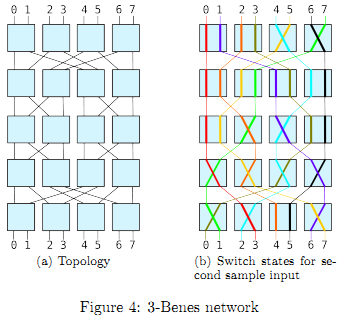 |
| ||||
Home Page
F.A.Qs
Statistical Charts
Past Contests
Scheduled Contests
Award Contest
| ||||||||||
| Online Judge | Problem Set | Authors | Online Contests | User | ||||||
|---|---|---|---|---|---|---|---|---|---|---|
| Web Board Home Page F.A.Qs Statistical Charts | Current Contest Past Contests Scheduled Contests Award Contest | |||||||||
|
Language: Routing
Description You work as an engineer for the Inane Collaboration for Performance Computing, where you are in charge of designing an intercommunication network for their computers. The network is arranged as a rectangular array of 2n - 1 rows, each having 2n-1 switches. A switch is a device with two input wires, X and Y, and two output wires, X' and Y'. If the switch is off, data from input X will be relayed to output X', and data from Y to Y'. If it is on, X will be connected to Y' and Y to X'. Additionally, there are 2n computers in the topmost and bottommost rows, and messages need to be sent between pairs of them. Notice that data from two different sources cannot share a wire but, of course, both pieces of data can be routed through the same switch on different inputs.
You have come to the conclusion that the network that best suits your purposes has the Beneš topology. A 1-Beneš network is just a switch. For n > 1, a n-Beneš network can be constructed recursively as follows:
 For example, Figure 4 shows the Beneš network for n = 3 (squares represent switches; computers in the top and bottom rows are not drawn, but assigned with integers from 0 to 7). Figure 4 shows a possible state of the switches; squares where two of the lines cross are switches that have been turned on. You may verify that this state allows us to simultaneously establish communication paths from computers 0, 1, 2, 3, 4, 5, 6, 7 at the bottom to 3, 7, 4, 0, 2, 6, 1, 5 at the top, respectively. You are given a set of pairs (a, b) of computers to connect simultaneously (where a is a computer in the bottom row and b a computer in the top row) by means of wire-disjoint paths, and you are to find how to select the state of all switches so that this can be accomplished. Input The first line of each test case is an integer n (1 <= n <= 13), meaning that you have 2n pairs of computers to connect, as described above. A line with n = 0 marks the end of the input and should not be processed.
Each line with n > 0 will be followed by another line containing 2n integers. The i-th integer (0 <= i < 2n) will be the computer in the topmost row that the i-th computer in the bottommost row needs to communicate with. Output The output for each case should have 2n-1 lines, each containing a binary string of length 2n-1 indicating, for each switch, whether it must be turned on (1) or off (0).
The input given will always have at least one solution. In case of several solutions, return the lexicographically smallest one. That is, the string in the top row must be lexicographically smallest; in case of a tie, the string in the second row must be lexicographically smallest, and so on. Outputs for different test cases should be separated by a blank line. Sample Input 2 3 2 1 0 3 3 7 4 0 2 6 1 5 0 Sample Output 00 11 11 0011 0000 0110 1111 1101 Source |
[Submit] [Go Back] [Status] [Discuss]
All Rights Reserved 2003-2013 Ying Fuchen,Xu Pengcheng,Xie Di
Any problem, Please Contact Administrator